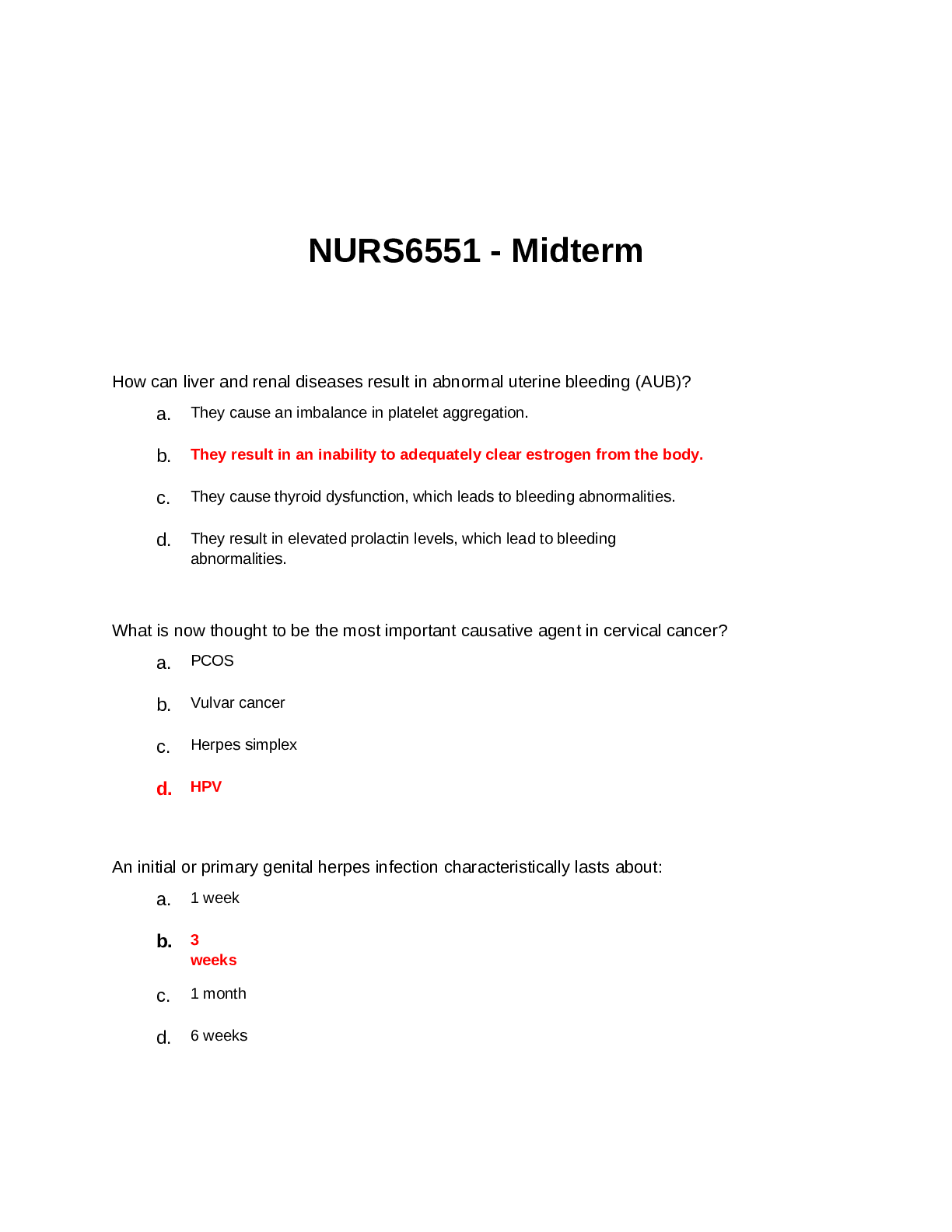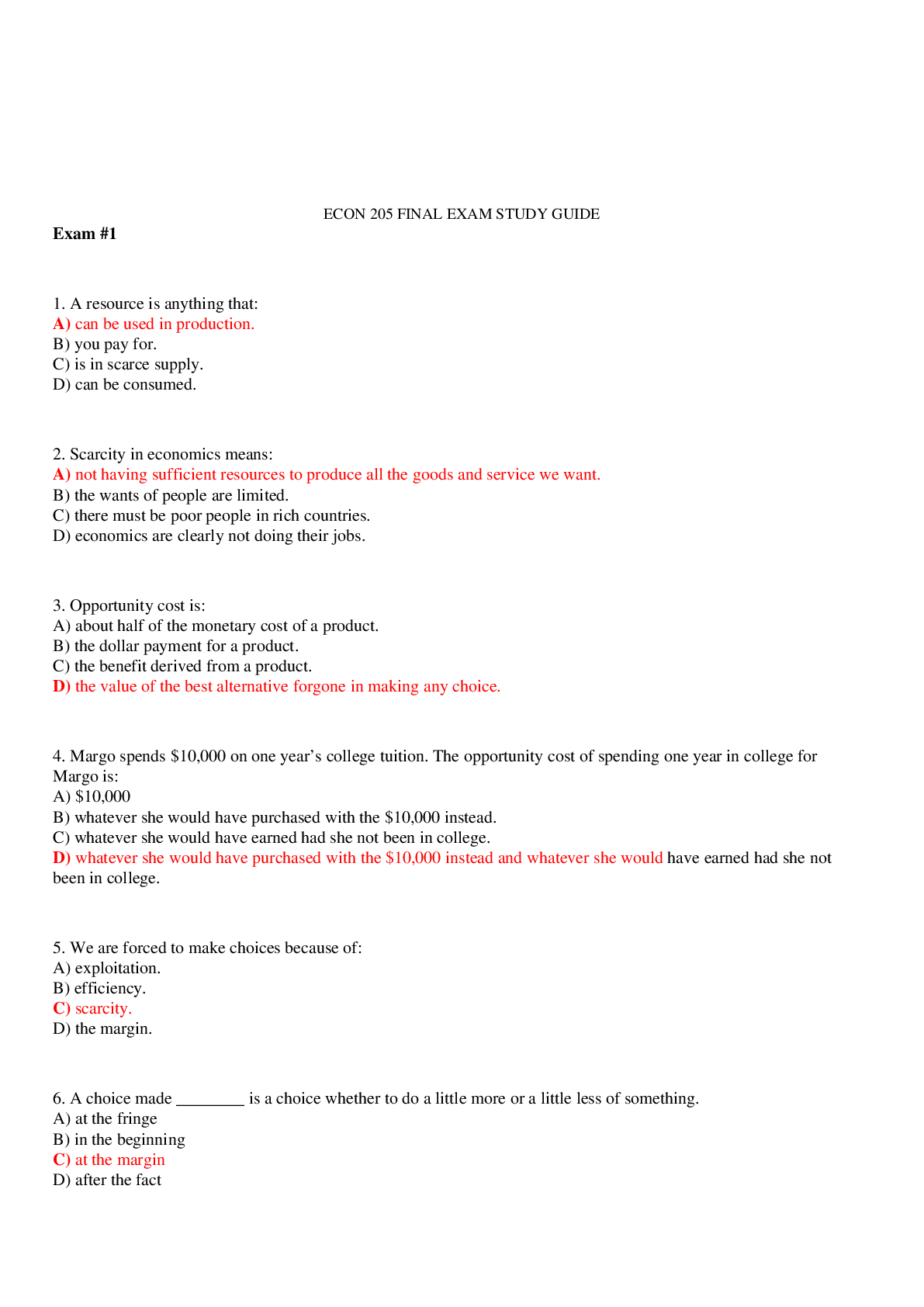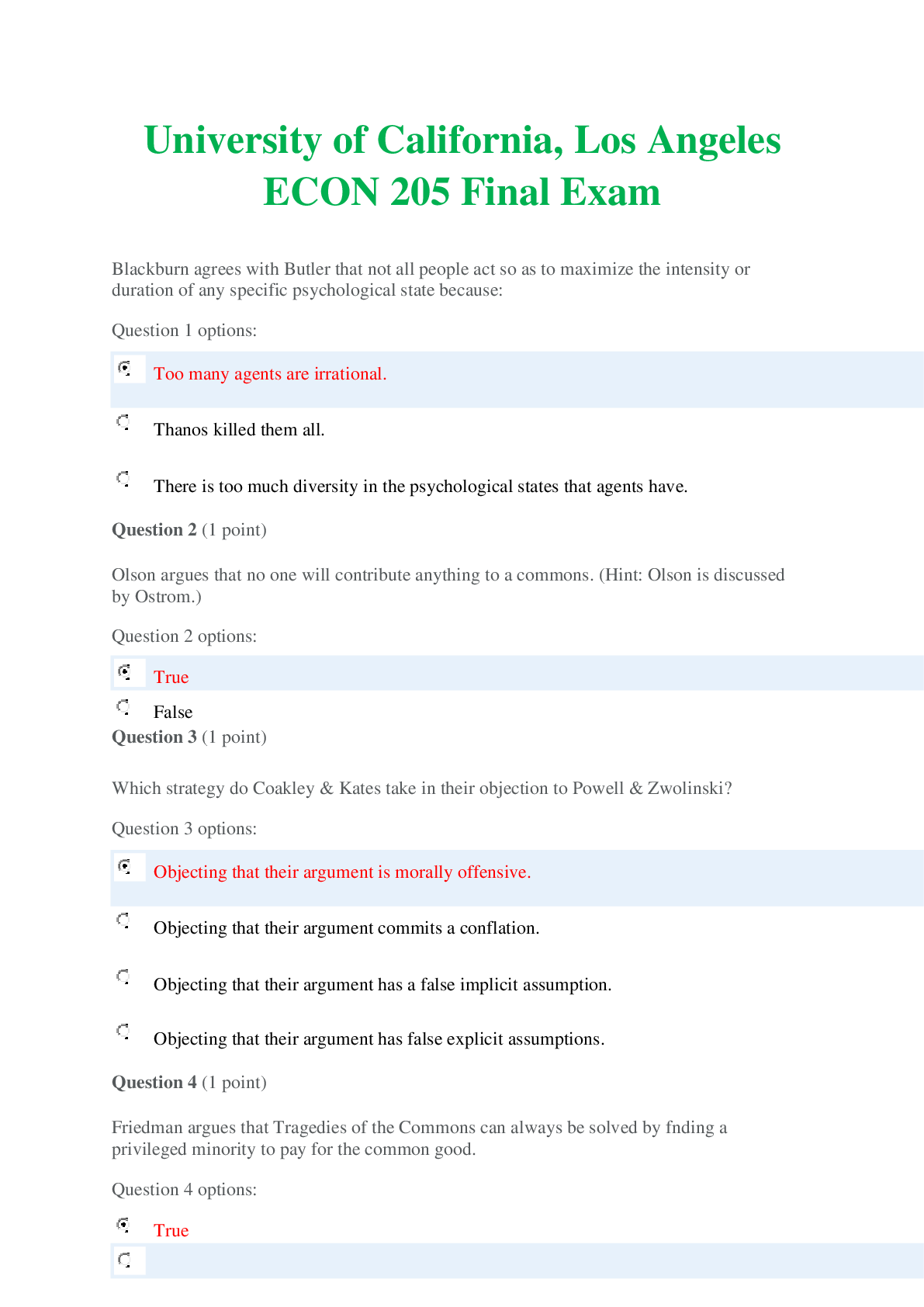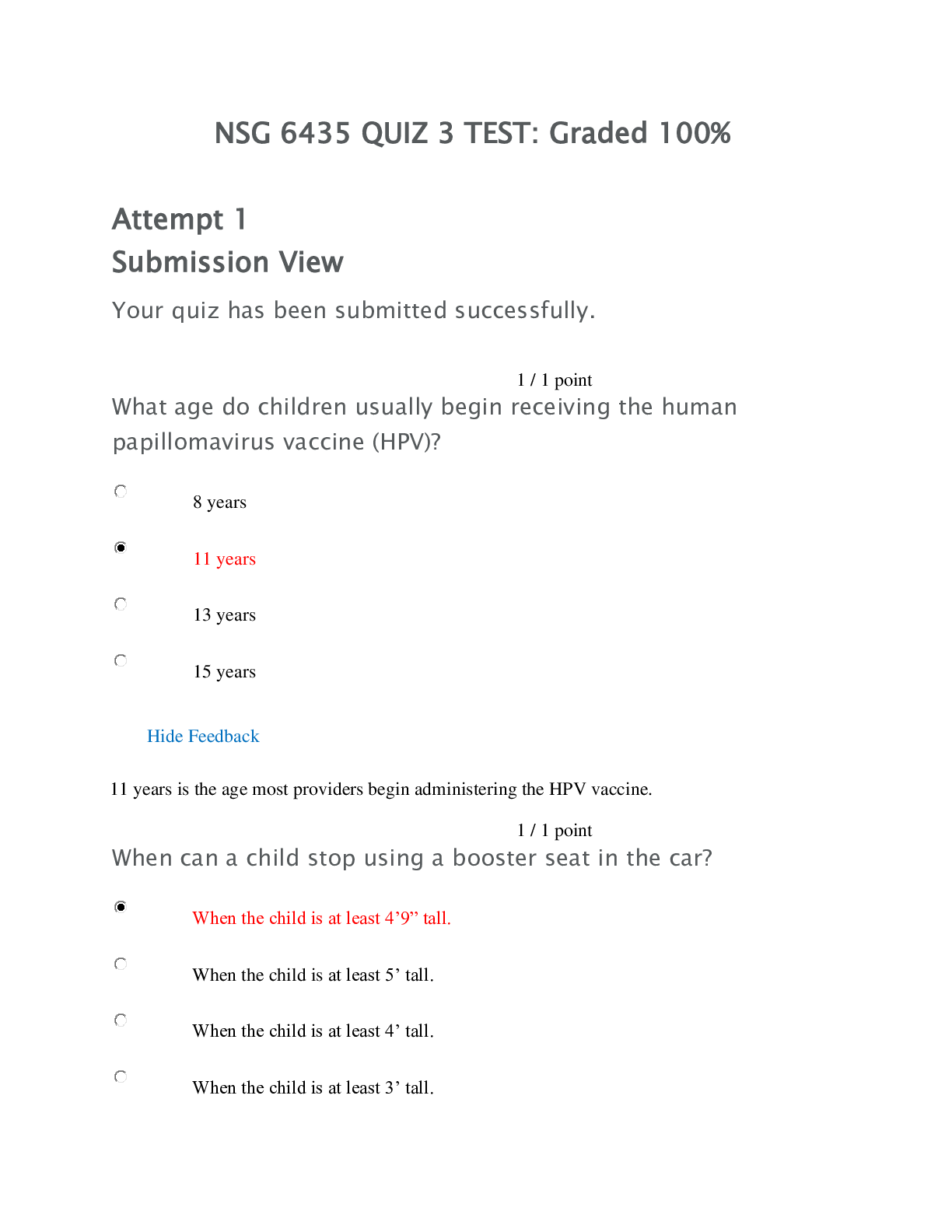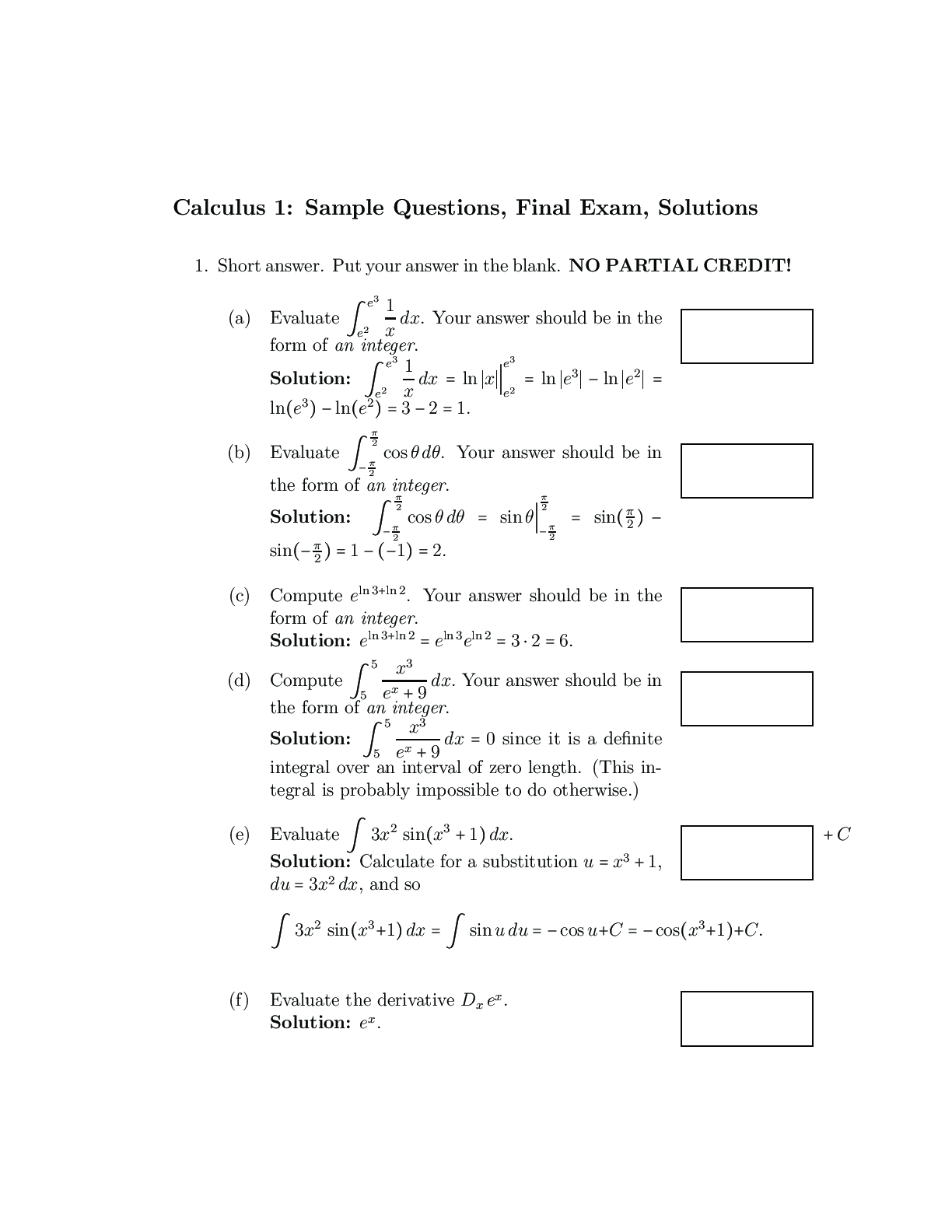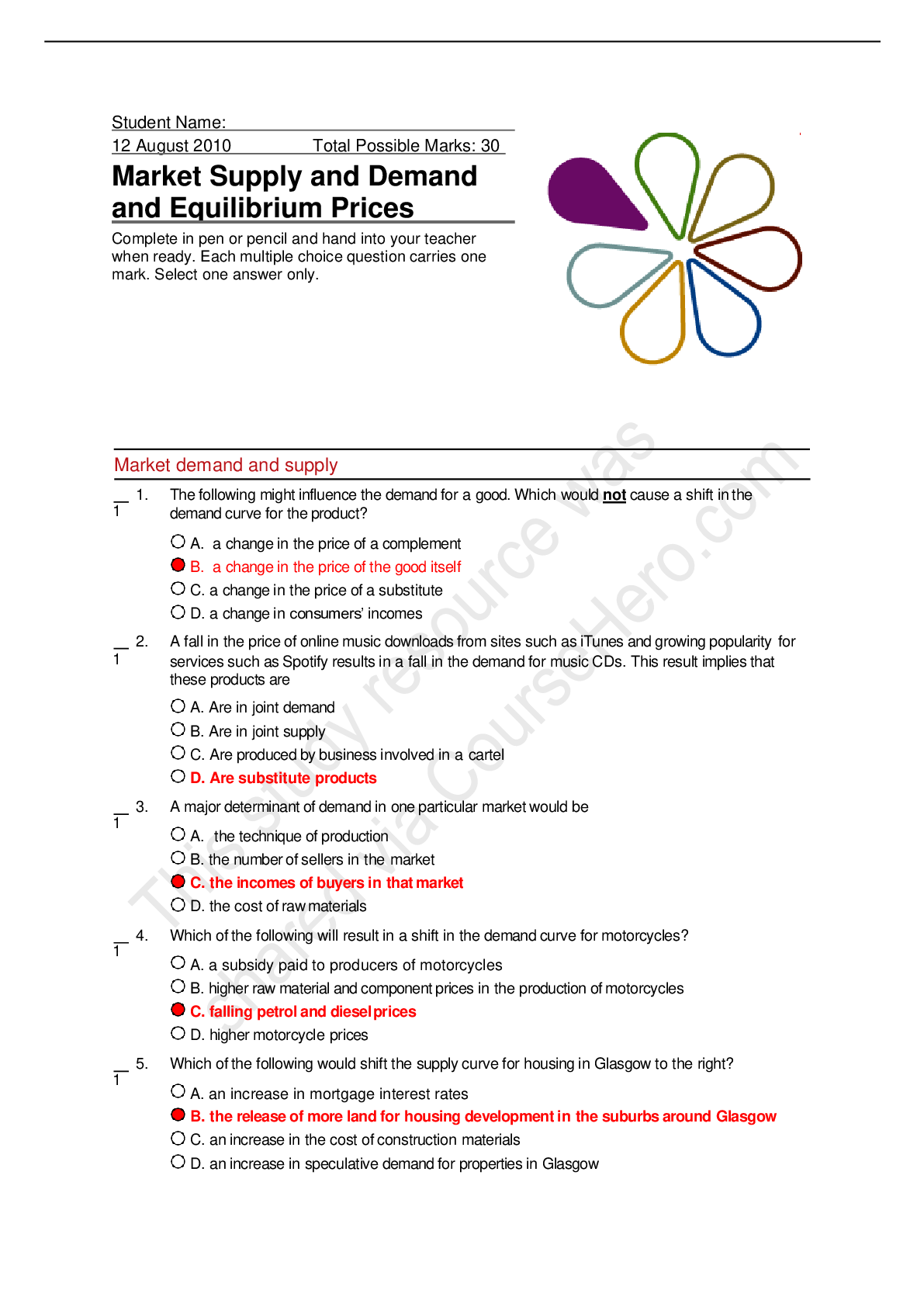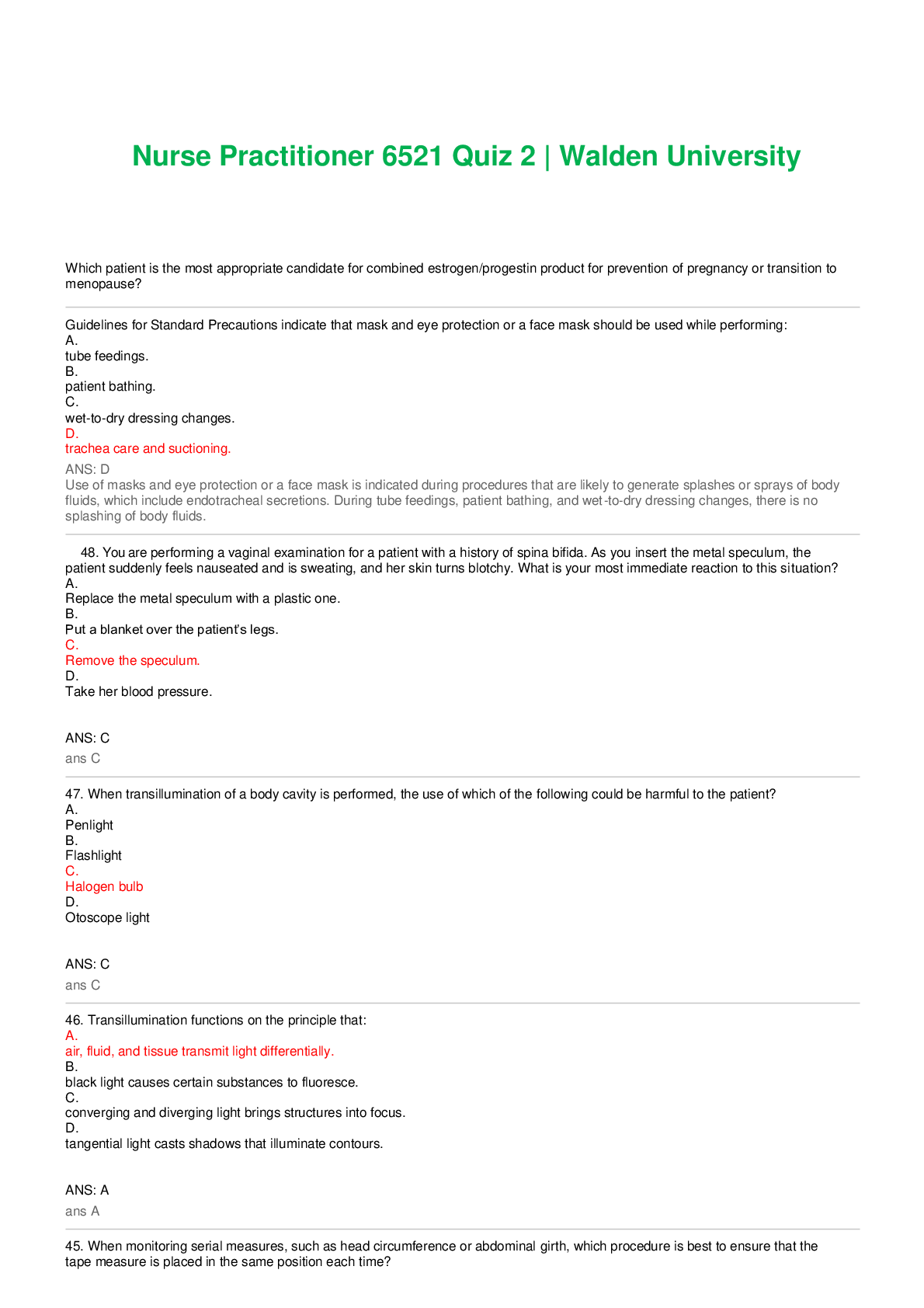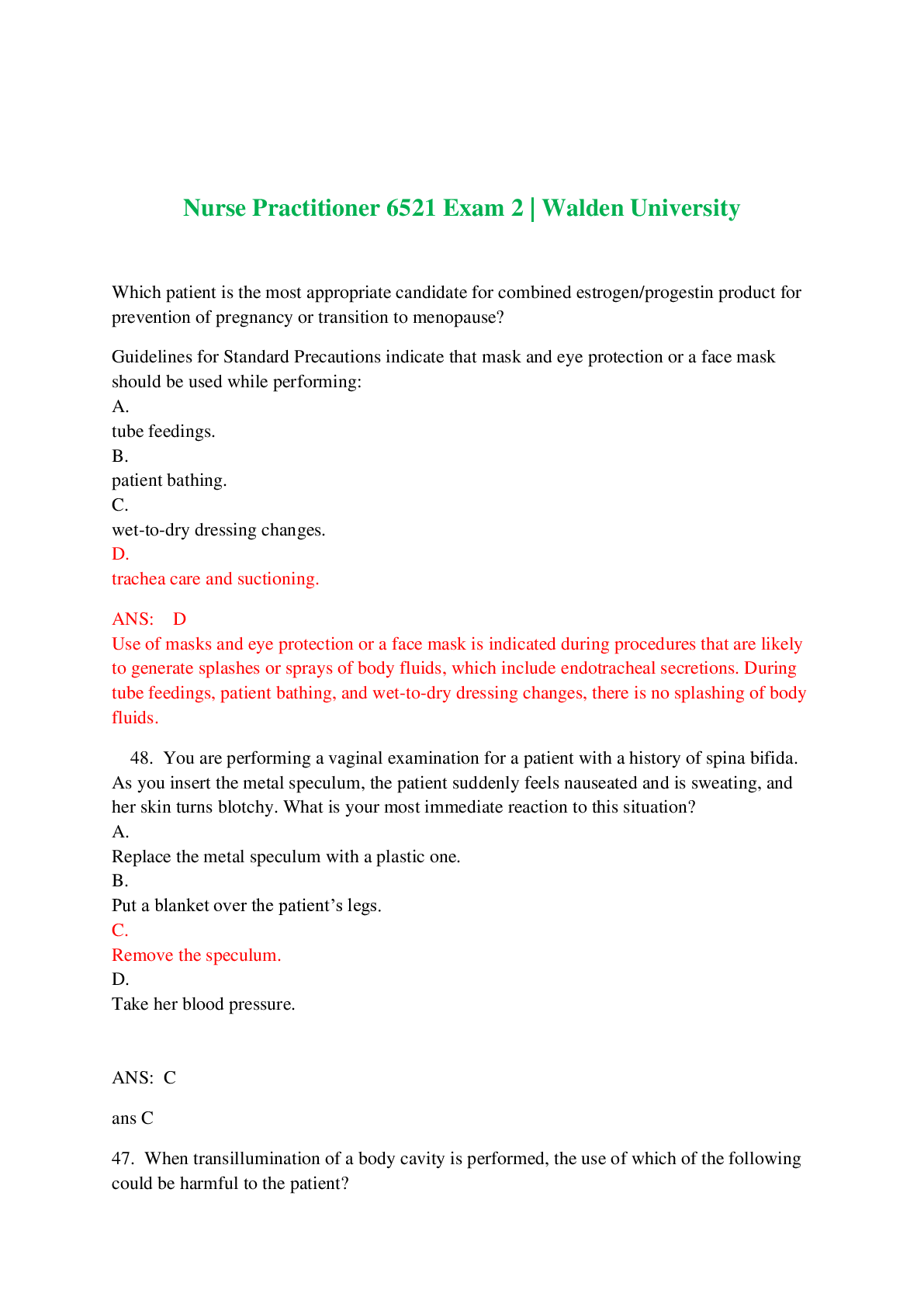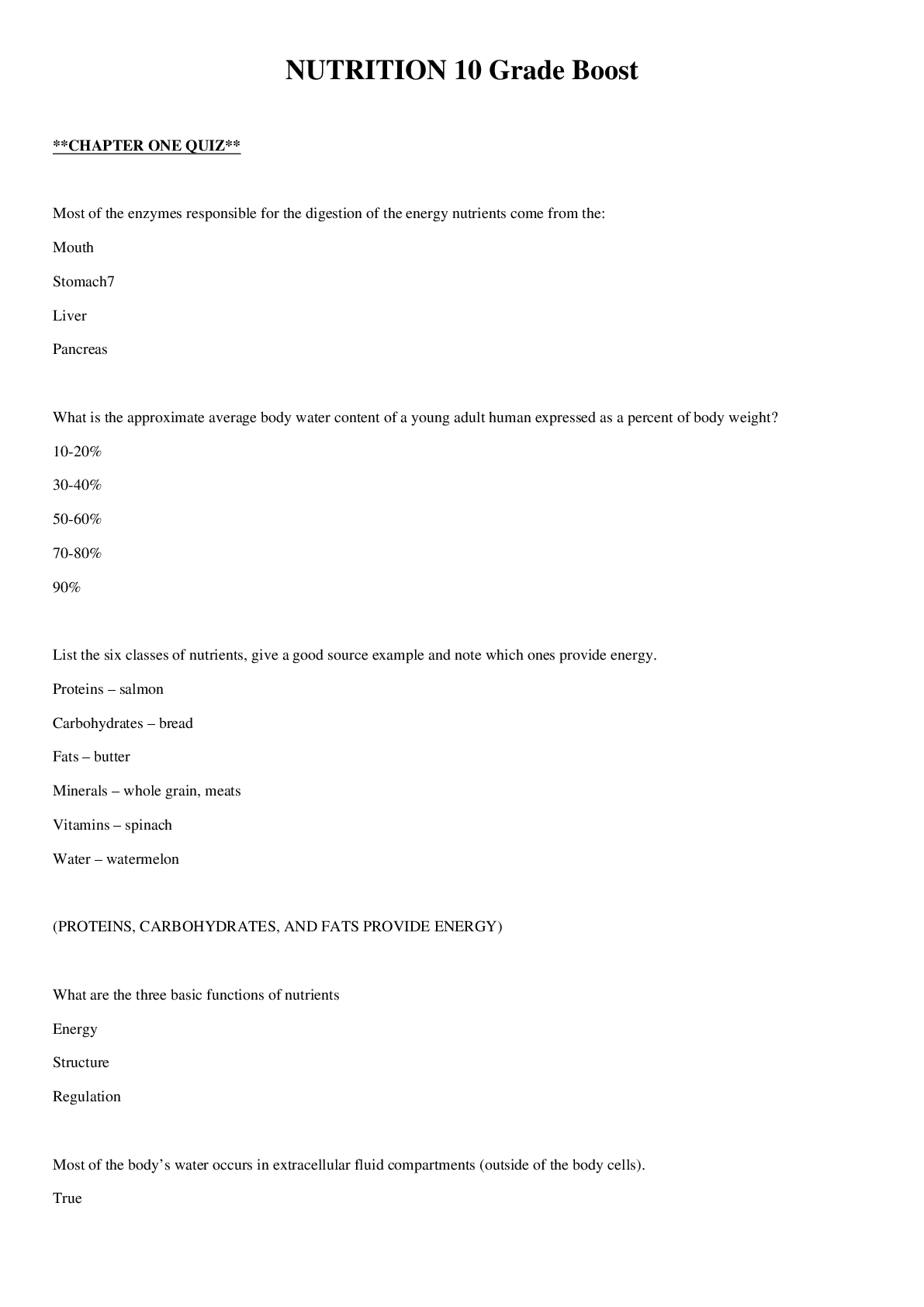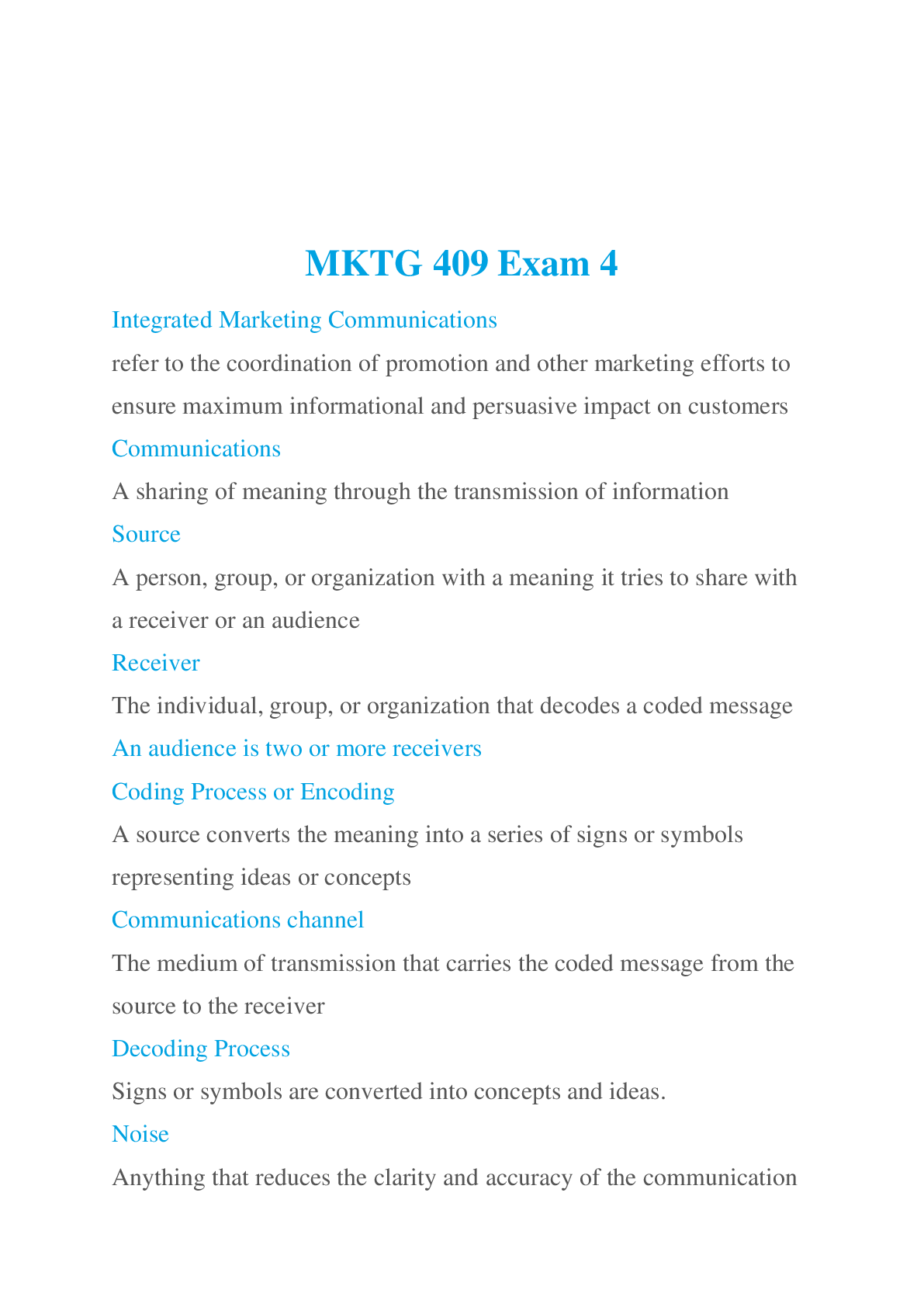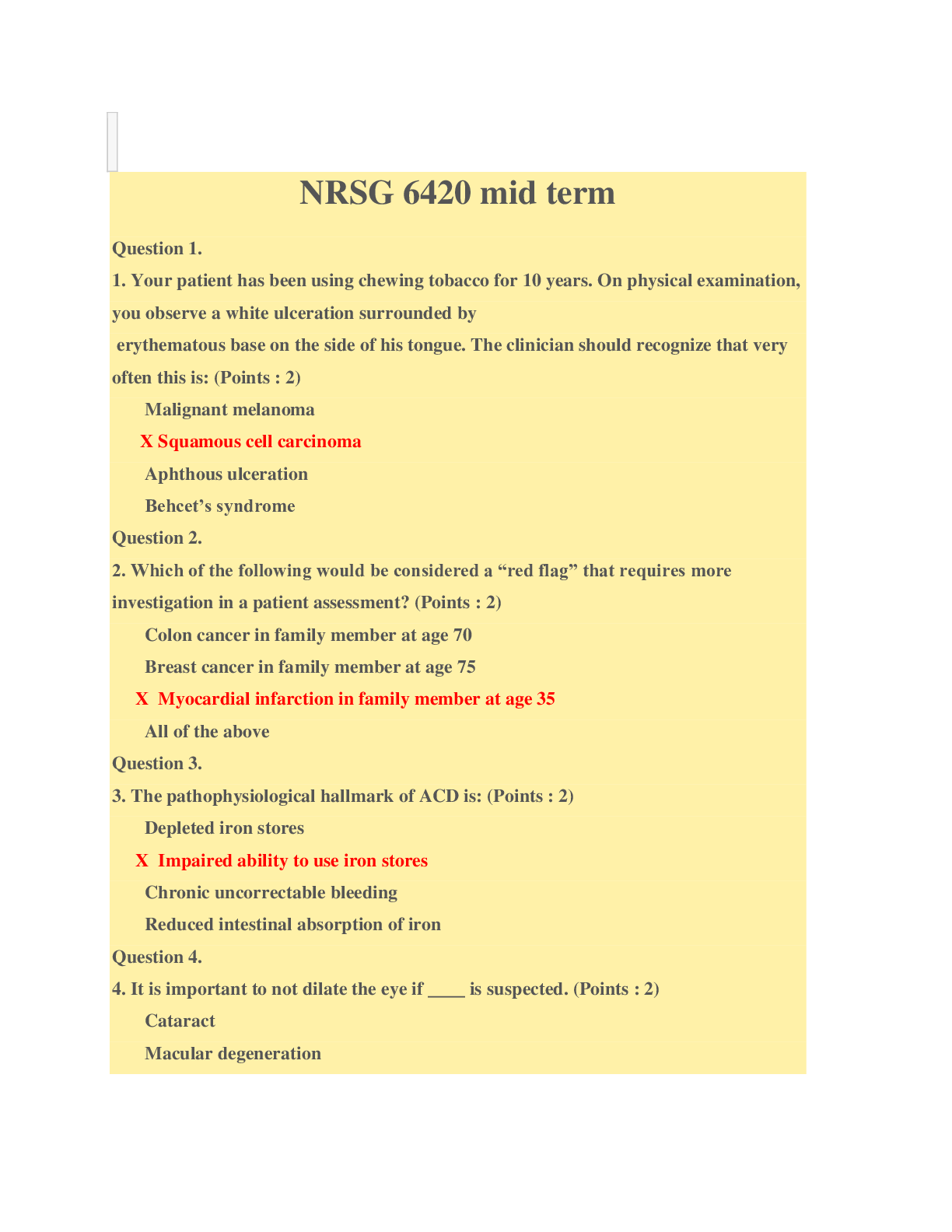SCIENCE 101 > EXAM > Science CNA Exam #2 (All)
Science CNA Exam #2
Document Content and Description Below
Science CNA Exam #2 CNA Exam #2 1. What is a contracture? The lack of joint mobility caused by abnormal shortening of a muscle 2. What is atrophy? The decrease in size or wasting away of tissue... 3. What is Flexion? Bending a body part 4. There are 3 types of (ROM) RANGE OF MOTION – WHAT ARE THEY? ROM - the movement of a joint to the extent possible without causing pain 1) active ROM- done by the person 2) passive ROM- you move the joints through their range of motion 3)active assistive ROM- the person does the exercises with some help 5. Where do you stand when ambulating a person? On the patient’s right side, (their weak side) 6. What is phantom limb pain? Occurs when the person feels pain in a limb (or extremity) that has been amputated. 7. How do you introduce yourself to a new resident/patient? Address ts the resident by their full name. If possible extend the hand to shake their and tell them you are a CNA 8. How do you balance a scale – (a stand up doctor’s scale)? At zero before weighing a person 9. Before you weigh a person what do you need to ask them to do? Go to the bathroom and take off their shoes 10. A resident is going to be discharged. You can do all of the following except? ** no patient teaching Pack their things-help them out, do not teach them about any medication or procedures. 11. How long does a tub bath last? No longer than 20 minutes 12. What is the absolutely water temperature for a tub bath? 105 fahrenheit 13. Peri-care temperature is between?** Warm or the temperature the person prefers. 105-109 degrees Fahrenheit usually 14. Peri-care is given (perineal care) is given WHEN? After a patient uses a bedpan, is incontinent, and as part of daily bathing routine. In daily bath, peri-care is given last 15. What is an Anticoagulant? To prevent someone from clotting when cut. Meaning they will bleed. What kind of razor is a must for someone on an anticoagulant? *** electric shaver Anticoagulant - A drug that prevents or slows down blood clotting.Must use electric shaver, don’t just safety razor 16. Then skin must be soft from moistening the skin with warm water, after the bath. Moist washcloth is applied for few minutes and pat dry. After you shave the patient 17. How are fingernails clipped according to IDPH? *** Clip one straight across, take nail files. Do not clip the nail all around. 18. What is Abduction? Moving a body part away from the midline of the body (to take something away) 19. What is Adduction? Moving a body part toward the midline of the body (to add something) 20. What is flexion? Bending a body part 21. What is plantar flexion? The foot is bent; bending the foot down at the ankle. 22. How do you give mouth care to an unconscious person? 1) position the person on 1 side with the head turned well to the side.(to prevent aspiration) 2) use only small amounts of fluid to clean the mouth 3) do not insert dentures. Dentures are not worn when person is unconscious 4) keep the persons mouth open with a padded tongue blade while cleaning the mouth with swabs. Do not use your fingers 23. How do you clean dentures? 1) brush the outer surfaces of the denture with back and forth motions 2) position the brush vertically to clean the inner surfaces of the denture. Use upward strokes 3) brush the chewing surfaces with back and forth motions. 24. What temperature is the water when cleaning dentures? Warm water 25. How do you store dentures that are not being worn? In cool water or in denture soaking solution 26. COMPLETE BED BATH water is what temperature? 110F and 115F (43.3C to 46.1C) for adults. For older person's, the temperature may need to be lower 27. Where do you start 1st with the bed bath process on the person? *** Cover the person with a bath blanket and remove top linens28. What do you use when giving a complete bed bath? Oral hygiene, shaving, hair, nail care equipment and glove 29. How do you dry the person you are bathing? By dabbing 30. What if a resident wants a partial bath & not a complete bed bath – what do you do? Let the nurse know. Give them a choice later. 31. What is a prosthesis? Device that replaced a body part that missing or deformed due to accident 32. How is a gait belt/transfer belt to be applied to the person? It is applied over clothing and around the waist 33. What is the purpose of heat/hot applications? 1.) Prevent infection 2.) Promote comfort 3.) Promote healing 4.) Reduce tissue swelling 34. What happens to blood vessels when heat is applied to them? Blood vessels in area dilate (blood flow increases) 35. What happens to vessels when cold is applied to them? Blood vessels contract and blood flow decreases 36. How long are hot/cold applications applied for? No longer than 15 or 20 mins 37. What are complications of hot & cold applications? Pain, burn, blister, poor circulation 38. What area is involved with a sitz bath? Involves immersing the perineal and rectal areas 39. What kind of fluid do you put in an AQUATHERMIA PAD?*** Distilled water 40. How often is the skin checked after applying a hot/cold application? Every 5 minutes 41. How are you to remove dirty linens? Roll each piece of dirty linen away from you. Don’t touch the front off the sheet. 42. Dirty linens must NEVER GO where? On the floor 43. When are dirty linens changed? Right away44. When a person is receiving oxygen therapy their person’s mouth will become very dry. 45. Due to the mouth being dry, mouth care is given how often? At least every 2 hours 46. You must check that the sponge on the stick is tight before using it. the person could choke on the foam pad if it comes off the side. 47. What all is used when giving mouth care to the unconscious person? Cleaning agent, sponge swabs, padded tongue blade, water cup with cool water, hand towel, kidney basin, lip lubricant, paper towels, gloves 48. How do you position the unconscious person for oral hygiene? Position the person on 1 side with the head turned well to the side to 49. What is the proper way to use an alcohol-based hand rub 50. What is friction? The rubbing of 1 surface against another 51. What is shearing? When skin sticks to a surface while muscles slide in the direction the body is moving 52. How many workers are needed to use a mechanical lift? At least 2 53. When are linens changed? Usually 1-2 times a week Or if soiled, damp, wrinkled, and wet 54. Linens are held? Away from you as possible 55. Clean linens are placed? On a clean surface 56. What happens with the extra linen you brought into a room? Put in the the dirty laundry, it is contaminated Extra Notes: ● Person Unit - Personal space, furniture, and equipment provide for patient by agency ● Patient and Residence room are designed to provide comfort, safety and privacy ● Most people are healthy and comfortable when room temperature is 68-74 fahrenheit ● Mouth Care given to unconscious patient every 2 hours● When transferring a patient you should never place your hands under a patient's arms because the patients bones are fragile ● A transfer belt should always be used for standing transfers unless contraindicated ● Always transfer toward the patients strongest side ● Hot packs, aquathermia pad, electric heating pads are heating applicants ● PROM - passive range of motion (pg 517) ● BID - Twice a day 6A Procedure Review 1. A person's unit is The personal space, furniture & equipment provided for the person by the agency or a private area 2. Staff can reduce noise & increase patient & resident comfort by: a. Controlling your voice b. Equipment carefully c. Keeping equipment in good working order d. Answer phone, call lights & intercoms promptly 3. Keeping light controls within the person's reach protects the right to Personal choice 4. When are bed wheels locked? Giving bedside care & transferring a person to & from the bed 5. Entrapment within the hospital bed system is a risk. Describe entrapment Being caught in or as in a trap 6. Only ______ and ______ items are placed on the over-bed table Clean & sterile 7. Where should you place a patient's or resident's bedpan when it is not in use? In the bottom drawer of the bedside stand 8. The call light must always be Within the person's reach9. Full visual privacy means To be completely free from public view while in bed 10.OBRA requires closet space for each resident. The closet must have Shelves & a clothes rack 1. Describe a closed bed Not in use, ready for a new patient or resident, made for a resident who is up during the day 2. Explain how used linens are removed from the bed One piece at a time, roll each piece away from you 3. ______, ______, & _______ linens are changed right away Wet, damp or soiled 4. Always hold _______ your uniform Linens away from your body and 5. What is the purpose of the plastic draw sheet? Keep the mattress & bottom linens clean & dry 6. An open bed is made for: a. Newly admitted person arriving by wheelchair b. Persons who are getting ready for bed c. Persons who are out of bed for a short time 7. When making an occupied bed, cover the person w/ _____, before removing the top sheet Sheet or light blanket 8. Surgical beds are made for persons: a. Returning to their rooms from surgery. A complete linen change is needed b. Who arrive at the agency by ambulance. A complete linen change is needed if the person is a new patient or resident or is returning to the agency from the hospital c. Who go by stretcher to treatment or therapy areas. A complete linen change is not needed d. Using portable tubs. Because the person has a bath, a complete linen change is needed9. What information do you need before making any bed? a. What type of bed to make – closed, open, occupied, or surgical. b. If you need to sue cotton draw sheet or a padded water proof draw sheet waterproof under pad incontinence product. c. If the person used bed rails. d. The person’s treatment therapy, and activity schedule e. Position restriction or limits in the person’s movement or activity. f. How to position the person and the positioning device. g. If the bed needs to be locked into a certain position h. When to report observation i. What patient or resident concerns to report at once. 10.When you are finished making the bed, the wheels should be _____ Locked 1. Define the following terms: a. Admission – the official entry of a person into a health care setting b. Discharge – the official departure of a person from a health care setting c. Transfer – moving the person to another health care setting 2. What is involved in admitting, transferring & discharging patients & residents? a. Privacy & confidentiality b. reporting & recording c. Understanding & communicating with the person d. Communicating with the health team e. Respect for the person & the person's property f. Being kind, courteous & respectful 3. During the admission procedure, the person complains of a severe headache. What should you do? Call for the nurse, stay w/ person. When nurse arrives, assist as needed4. Before measuring weight & height, what information do you need from the nurse & the care plan? a. When to measure weight & height b. What scale to use c. If height is measured with the person in bed d. When to report the measurements e. What patient or resident concerns to report at once 5. You are transferring a person to another nursing unit. What information about the transfer do you need to report & record? a. the time b. Who helped c. Where they were taken d. How they were transferred e. How they tolerated the transfer f. Who received the person 6. A nursing center resident is packing, the person tells you that she wants to leave the center. The person doesn't have a doctor's order for discharge. What should you do? Tell the nurse, the nurse and/or social worker will handle the matter T or F: 1. All old people are the same. __F__ 2. Older persons are at risk for health problems and disabilities __T__ 3. Many older people enjoy a fulfilling sex life _T__ 4. Older people are lonely & isolated _F__ 5. Most older persons live in nursing centers __F_ 6. Gerontology is ______ The study of old age, process of aging & the particular problems of old people 7. These factors affect how people cope with aging: a. Health status b. Life experiences c. financesd. education e. Social support systems 8. List 3 changes that occur in the eyes with aging that increase a person's risk for falls a. Eyes lose the ability to focus on new objects b. Lens becomes more rigid with age c. Clear vision is reduced 9. ___________ is the time when menstruation stops & menstrual cycles end menopause 10.Most older persons live in their own homes. List five additional housing options available to older person a. Adult day care b. senior citizen housing c. residential hotels d. Board & care homes e. Adult foster care 1. Alopecia means ___________ Hair loss 2. __________ is infestation of the scalp with lice pediculosis 3. You assist person with hair care. The nursing process reflects the person's ___, ______, _____, ______, & _______. Culture, heath history, personal choice, self-care skin, scalp 4. Before brushing & combing hair, what information do you need from the nurse & the care plan? a. How much help the person needs b. What to do for matted or tangled hair c. What to do for curly, course or dry hair d. What hair care products to use e. What observations to report & record f. The person's preferences & routine hair care measuresg. When to report observations h. What patient or resident concerns to report at once 5. A resident's hairbrush has sharp bristles, what should you do? Report concerns about the person's brush or comb 6. You are shampooing a resident's hair during her tub bath, how will you keep shampoo out of the person's eyes? Have the person hold a wash cloth over the eyes 7. Before shaving a person, what information do you need from the nurse & the care plan? a. What shaver to use b. If the person takes anticoagulant drugs c. When to shave them d. What facial hair to shave e. If there are tender or sensitive areas on the person's face f. When to report observations g. What observations to report & record h. What patient or resident concerns to be report at once 8. A patient has diabetes. What health team member cuts the person's toenails? The RN or podiatrist 9. A patient has an IV in his left arm. You are changing the person's grown. The gown is removed from the _______ arm first. No IV arm 10.Remove clothing from the _______ side first. Apply clothing to the ____ side first Strong, weak 1. Oral hygiene reduces the risk for ______, & _______, Cavities & periodontal disease 2. Which observation made during oral hygiene are reported to the nurse? a. Dry, cracked, swollen or blistered lips b. Mouth or breath odorc. Redness, swelling ,irritation, sourness or white patches in the mouth or on the tongue d. bleeding swelling or redness of the gums e. loose teeth f. Rough, sharp, or chipped areas on dentures 3. You are giving mouth care to an unconscious person. What should you use to keep the person's mouth open? Padded tongue blade 4. How often is mouth care given to the unconscious person? At least every 2 hours 5. You are cleaning a resident's dentures. Explain how you will protect the dentures from breakage Never carry dentures in your hands, always use a denture cup or kidney basin 6. Explain why hot water is not used to clean or store dentures Hot water cause dentures to lose their shape 7. To promote safety when giving a shower, you must turn ________ water on first them ________ water. Turn ______ water off first then ______ water Cold water then hot, hot water then cold 8. To safely apply powder, you need to a. Turn away from person b. Sprinkle a small amount of powder onto your hand or cloth c. Apply the powder in a thin layer d. Make sure powder does not get on the floor 9. A complete bed bath involves Washing the person's entire body in bed (100F* & 115F*) 10.Why might a towel bath be given to a person dementia Quicker, soothing & relaxing 11.Before assisting a person with a tub bath or shower, what information do you need from the nurse & care plan [Show More]
Last updated: 2 years ago
Preview 1 out of 12 pages
Buy this document to get the full access instantly
Instant Download Access after purchase
Buy NowInstant download
We Accept:

Reviews( 0 )
$13.50
Can't find what you want? Try our AI powered Search
Document information
Connected school, study & course
About the document
Uploaded On
Nov 08, 2022
Number of pages
12
Written in
Additional information
This document has been written for:
Uploaded
Nov 08, 2022
Downloads
0
Views
116













